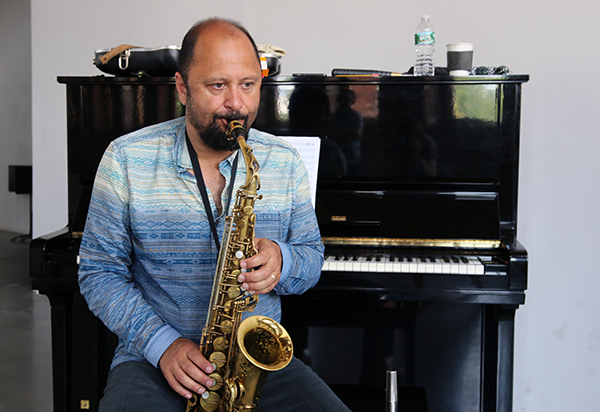Jun 3, 2025 11:25 AM
In Memoriam: Al Foster, 1943–2025
Al Foster, a drummer regarded for his fluency across the bebop, post-bop and funk/fusion lineages of jazz, died May 28…

Hafez Modirzadeh
(Photo: Jill Steinberg)Like generations of saxophonists, the teenage Hafez Modirzadeh first modeled himself on Charlie Parker. Now 58, Modirzadeh retains, he said, the sensibility of an inside player who respects the masters of chromatic harmony, from beboppers to Bach and beyond.
But his calling has not simply been to absorb chromaticism. It has been to illuminate the biases associated with that system by elevating the status of pitches between the half-tones. In doing so, he has fashioned a distinctly rich aesthetic—if not a blueprint for pancultural parity.
“I want to decolonize the chromatic supremacy,” he said.
The aim, at first, was to incorporate into his sonic concept the microtones of the Persian dastgah drawn from his father’s heritage.
“What was compelling me was to understand how these tones could be reconciled with not sounding out of tune within the jazz language,” he said.
Over the years, that framework, which he calls “chromodality,” has expanded to encompass the traditions of many lands and cultures, among them Turkey, Arabia and Native America. While he has documented his evolution on much-admired albums, their influence, by his own account, has not matched their acclaim. So, he said, he may be ready to move on to forms of self-expression yet unknown. But before he does, he has one more entry in the chromodality series: Facets (Pi).
“Facets is the endline,” he declared.
Released March 5, Facets is perhaps Modirzadeh’s most daring album. It not only features the retuning of a piano — an act, he said, that many academics liken to the sacrificing of a sacred cow — it presents the retuned instrument in solo and duo formats. That strategy leaves the piano, and the challenge to chromatic hegemony he is taking on by altering the instrument’s seemingly fixed set of half-tones. more exposed than on his previous albums. On them, the retuned pianos largely appear amid combos.
To meet the challenge, Modirzadeh, a longtime professor at San Francisco State University, flew east in 2018 and 2019 for separate recording sessions with pianists Craig Taborn, Tyshawn Sorey and Kris Davis. All make beautiful music playing pianos on which eight pitches are tuned down. The pitches cover an octave-and-a-half in the keyboard’s mid-to-upper register, precisely where a jazz pianist’s right hand tends to roam.
To the uninitiated, the album’s 18 short pieces might seem disorienting. But even the most biased ear should discover a kind of familiarity in some pieces, particularly those in which Modirzadeh has integrated Thelonious Monk’s themes, like “Pannonica,” into his score. Though Davis and Taborn add their own abstractions to the material, their interpretations only reinforce the feeling that, whatever a keyboard’s temperament, Monk’s idiosyncratic intervals can evoke a quarter-tone quality.
Compared with Monk’s music, that of Johann Sebastian Bach might appear less adaptable to Modirzadeh’s world of microtonal resonance. Yet Taborn and Sorey have little trouble finding the affinities and exploiting them, using a theme from the well-tempered Baroque master’s “Goldberg Variations,” written into a score, as a reference point for solo explorations very much of that world.
“What strikes me is how quickly you begin to acclimate,” Taborn said. “[The retuning] starts to reorient your sense of how those resonances work. Then, if you go back to a well-tuned, even-tempered instrument, it sounds out of tune.”
As Sorey put it: “You hear sound in another way. You start to understand why certain notes resonate the way they do. It was about the decay of the sound. I wanted the note to hang out a little bit. It’s not really about being pianistic per se but about getting the sound itself — a meditative way of responding.”
Nowhere is that meditative response more clearly conveyed than in the album’s penultimate piece, “Facet 39 Mato Paha.” Inspired by Modirzadeh’s pilgrimage to the mountain of the title, the music has an elegiac quality. As it unfolds, Sorey’s piano lingers on each fading phrase, the retuned pitches mixing with Modirzadeh’s tenor saxophone in mournful contemplation.
With the recording of that tune, Modirzadeh said, he has come full circle. The last tone he plays on the tune and on the album — a B-flat rising to become a B natural — was also the first tone on his first album, 1992’s In Chromodal Discourse.
“It gets back to the idea of being and becoming: Our tones, just like us, are in a state of becoming one another,” he said. “It also defies the notion of chromatic separation.” DB

Foster was truly a drummer to the stars, including Miles Davis, Sonny Rollins and Joe Henderson.
Jun 3, 2025 11:25 AM
Al Foster, a drummer regarded for his fluency across the bebop, post-bop and funk/fusion lineages of jazz, died May 28…

“Branford’s playing has steadily improved,” says younger brother Wynton Marsalis. “He’s just gotten more and more serious.”
May 20, 2025 11:58 AM
Branford Marsalis was on the road again. Coffee cup in hand, the saxophonist — sporting a gray hoodie and a look of…

“What did I want more of when I was this age?” Sasha Berliner asks when she’s in her teaching mode.
May 13, 2025 12:39 PM
Part of the jazz vibraphone conversation since her late teens, Sasha Berliner has long come across as a fully formed…

Roscoe Mitchell will receive a Lifetime Achievement award at this year’s Vision Festival.
May 27, 2025 6:21 PM
Arts for Art has announced the full lineup for the 2025 Vision Festival, which will run June 2–7 at Roulette…

Benny Benack III and his quartet took the Midwest Jazz Collective’s route for a test run this spring.
Jun 3, 2025 10:31 AM
The time and labor required to tour is, for many musicians, daunting at best and prohibitive at worst. It’s hardly…